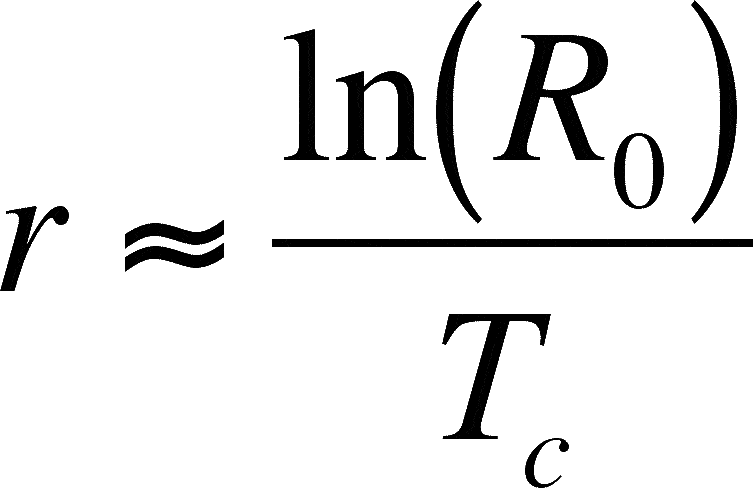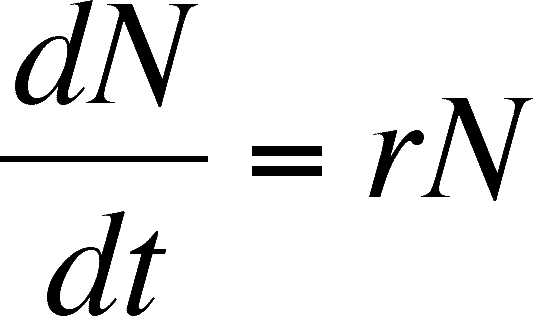|
|
BIOL
4120
Principles of Ecology
Phil Ganter
320
Harned Hall
963-5782
|
The damaged
cactus arm above is home to a community of microbes and insects.
The populations of each species there are living in a temporary
habitat and face the certainty of extinction when the damaged
tissue has been consumed. |
Lecture 10 Population Growth
Email me
Back to:
Overview - Link
to Course
Objectives
Describing a Population
Demography
is the science of life tables
Life
Tables are accounting of births and death in a population
Usually the life span of an
individual is broken into stages (egg, larvae, etc.) or by age intervals
or classes (0-5 years, 5-10, etc.)
Cohort
- all of the individuals born at the same time
- x = the interval
- nx = the number
alive at the START OF THE INTERVAL
- lx = age
specific survivorship -- fraction
of cohort alive at the START OF THE INTERVAL
- dx =
age specific mortality -- number dying in the interval
- qx = age
specific mortality rate -- death rate for individuals of a specific
age
- ex = age
specific life expectancy - number of years left for an organism
of a particular age.
- Life expectancy is not
always maximal at birth!!
- bx = age
specific natality -- number born in the interval
- mx = age
specific birth rate - the per female rate of offspring production
for females of a particular age.
- R0 = net replacement
rate = the number of females alive in the next generation for each female
alive in the present generation.
- Tc = generation
time -- the average time between a birth of a member of the cohort
and the birth of a member's offspring
- Age
specific means that the parameter varies with the individual's
age
By convention, the first age interval
has the notation 0, so the number in the cohort at the start is n0.
- n0 is
also the Cohort size - a Cohort
is the group of newly born organisms that are followed throughout their
lives in the life table
Another convention (especially
for human life tables) is to multiply the number in the lx column
by 1000 (if it is actually 0.562, then it reads 562).
However, if you wish to calculate
the net replacement rate (equation given below), then you must either convert
lx back to a proportion or you will be calculating the number
of females in the next generation per 1000 females alive in the present
generation!
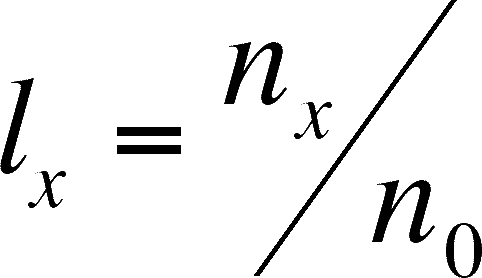

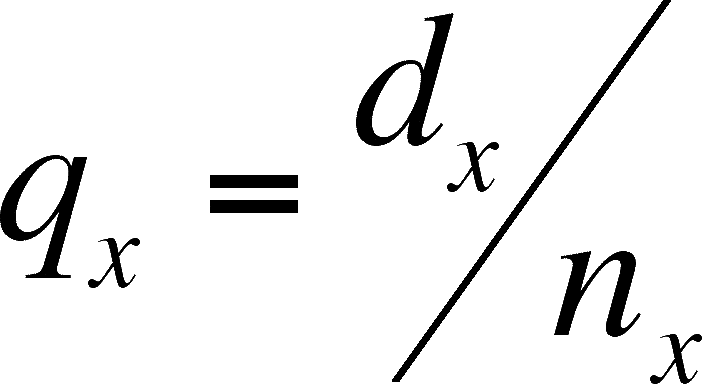
If we plot log (nx) versus age,
we can see where most of the mortality occurs by where the numbers drop
- Type
I Mortality curve
- most mortality comes late
- characteristic of K-selected
organisms (us)
- often associated with organisms
that put a lot of resources in to postnatal care
- Type
II Mortality curve
- mortality constant throughout
life
- results in a constant proportion
of each age class surviving
- birds are the classic example
- Type
III Mortality curve
- most mortality comes early
- characteristic of r-selected
organisms
- many exceptions to this generality
Life Expectancy
To calculate ex, we will
need to tack on another pair of columns to make it easier to do. This column
is Lx, the average number alive in interval x. This is simple to
do:
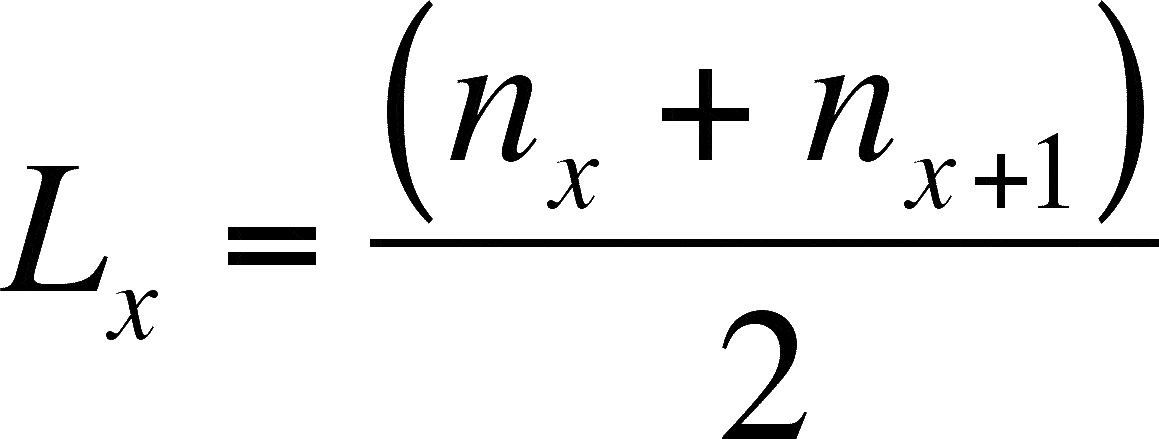
From this column, we can get Tx,
which is the sum of all of the Lx values from x until the age that the last
member of the cohort dies (this is symbolized by L°).
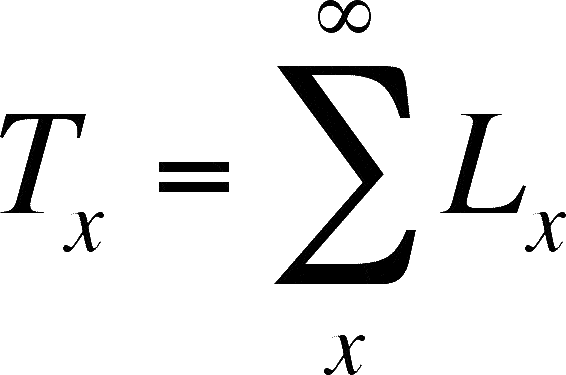
Life expectancy at age x is simply the average number
of years lived by members of the cohort that are age x.
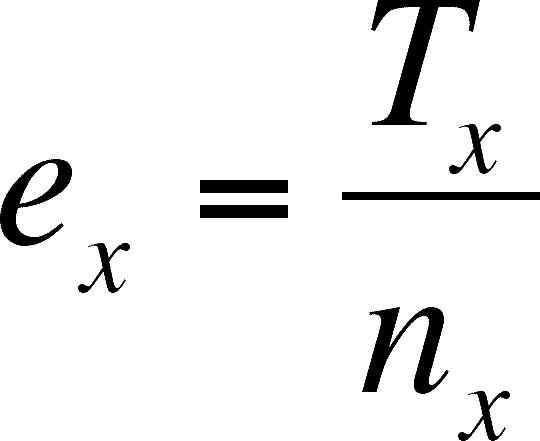
Net Replacement
Rate
Net replacement rate is a measure
of relative growth. It is the number of females alive in generation x+1 for
each female alive in generation x. If it is greater than 1, the population is
growing as there are always more females alive in the next generation than in
the present. If less than 1, the population is decreasing (less than 1 female
in the next generation per each alive in the present generation), and a net
replacement rate of 1 means each female is exactly replaced in the next generation,
so the population is stable, neither growing nor declining.
If we eliminate the males and add
a column containing births, then we can calculate the net replacement rate.
First, we must calculate the per capita birth rate (mx)
for females of age x (females only!)
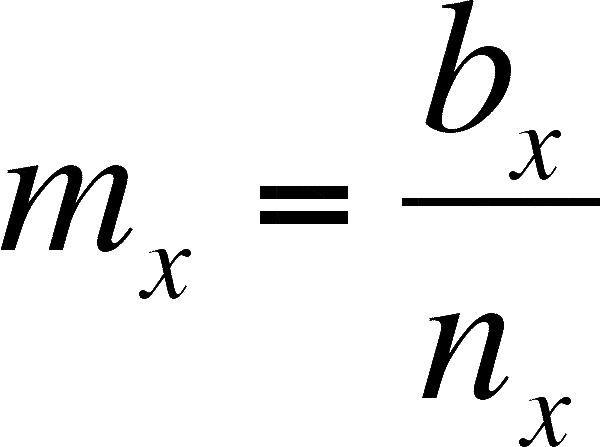
The net replacement rate is the sum of age-specific
birth rates times the age specific survivorship. This means that an age class's
contribution to the replacement rate must take account of the probability of
surviving to that age.
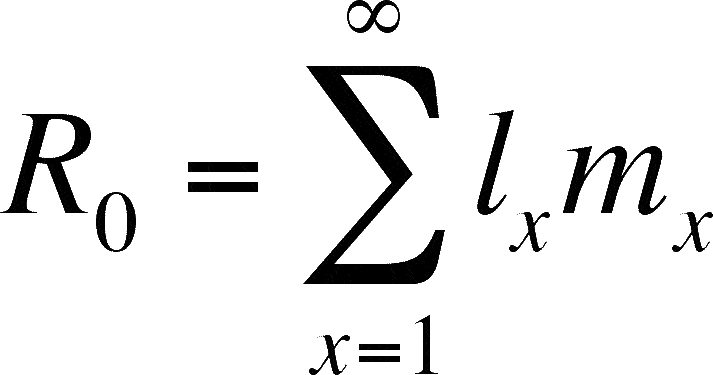
The net replacement rate is a measure
of population growth rate.
If it is 1, then the population
in neither growing or declining in size (a stable population).
If it is less than 1, the population
is declining by that proportion each generation (if it is 0.5, then the population
will be half as big each generation).
A value over 1 indicates a growing
population (a value of 2 is a population that doubles each generation).
Generation
Time
Assume that the net replacement
rate is near 1. If so, we approximate the generation time as:
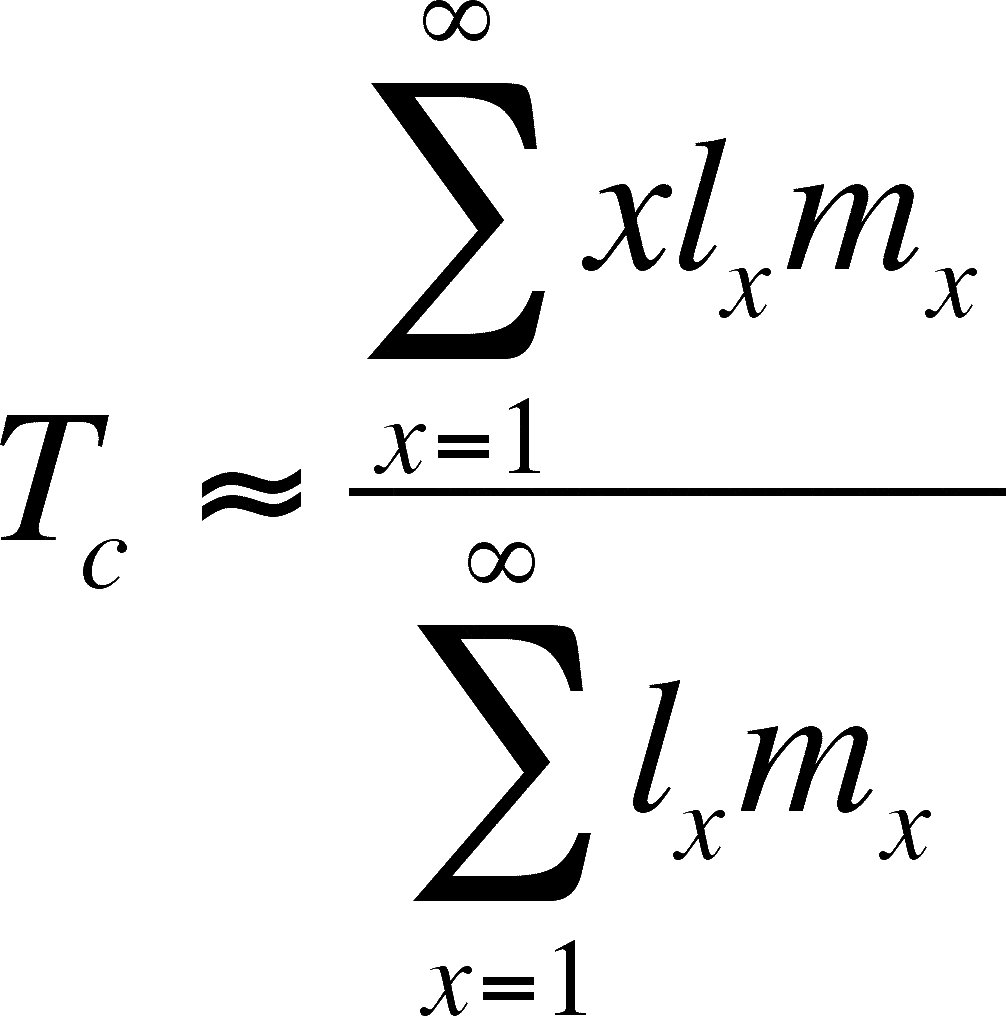
The approximation is due to the
discrete nature of a life table, versus the continuous nature of time (an
integral approach would get the exact figure)
Deterministic
Models of Population Growth:
A model
is a description of a natural phenomenon
Can be
- verbal
(a story)
- pictorial
(graphs)
- mathematical
(equations)
Can be:
- Deterministic
- exactly predicting the outcome
- Stochastic
- giving a range of possible outcomes, with a probability of each occurring
Geometric (discrete generations)
and Exponential (overlapping generations) Population Growth
Geometric
Population Growth
Stochastic
Processes and Models:
Stochastic demographic process are
random changes in birth and death rates from year to year
- Random here means unpredictable
- Random fluctuations in demographic
processes can arise from two sources
- Environmental Stochasticity
- fluctuations in edaphic or biotic factors that influence demographic
processes, such as temperature and disease causing changes in the mortality
rate.
- Demographic
Stochasticity - fluctuations in death or birth rates that
are not caused by environmental sources. These fluctuations may
be due to genetic changes (perhaps due to Genetic Drift) or to random
alterations of organisms physiology.
We can include stochastic change
into our demographic models
- Deterministic
models make specific, unique predictions about the size of
populations at a specific time in the future - these are the models we have
dealt with so far.
- Stochastic
models are usually based on deterministic models, but make
allowance for the fact the things vary in the real world
Predictions of population size made
using stochastic models are couched as probability distributions of possible
population sizes
- X axis is the size of the population
at some time in the future
- Y axis is the probability of
the population being at some particular size
One would say that the size
of a population is predicted to be 1232 organisms in six months if using
the prediction from a deterministic model.
One would say that, in six months,
there is a 95% chance that the population will be somewhere in the range
of 985 to 1456 if using the prediction from a stochastic model.
In general, the longer in
the future you try to predict population size, the larger the range of
possible sizes
Population
Extinction
Populations go extinct for many
reasons
Some populations are, by nature,
destined for extinction because their habitat is temporary
- many microbes live in situations
that are temporary (my yeast are an example)
- plants that colonize openings
in the forest live in habitats that will return to forest and become unsuitable
for them
- populations of protists in
temporary ponds
Some populations go extinct because
of some unusual climatic event (very cold spell, flooding, severe storm, volcanic
eruption [not really climatic]
Some populations go extinct due
to Habitat Alteration by human
activity
Probability of extinction
is related to population size
smaller populations have a higher
probability
Allee
effect - the negative effects felt by populations that are
smaller than some critical value (which is specific to each species)
- failure to find a mate
- Genetic drift
may fix alleles in the population that are harmful (increase death rate
or decrease birth rate)
- Inbreeding
will increase the frequency of homozygotes (and, therefore, reduce heterozygosity)
at loci with more than one allele present in the population
- Homozygotes are sometimes
less fit and may expose some recessive alleles, normally masked by the
dominant gene in heterozygotes
- Individuals with one or
more detrimental alleles made homozygous by inbreeding may not be able
to survive and reproduce in the population's environment.
Terms
Demography, Life Tables, Cohort, nx,
lx, dx, age specific mortality, qx, age specific
mortality rate, ex, age specific life expectancy, bx, age
specific natality, mx, age specific birth rate, R0,
Tc, generation time, Age specific, n0, Type I
Mortality curve, Type II Mortality curve, Type III Mortality curve,
Life Expectancy, Net Replacement Rate, Generation Time, Model, Verbal Model,
Pictorial Model, Mathematical
Model, Deterministic
Model, Stochastic
Model, Geometric Population Growth, Non-overlapping generations,
Discrete Equations, Exponential Population Growth, Overlapping generations,
Continuous Equations, Intrinsic Rate of Natural Increase, Environmental Stochasticity,
Demographic Stochasticity, Determinstic models, Stochastic models, Habitat
Alteration, Allee effect, Genetic drift, Inbreeding
Last updated February 4, 2007





